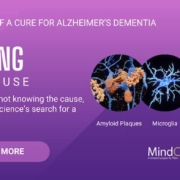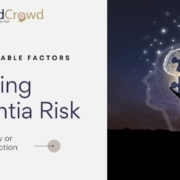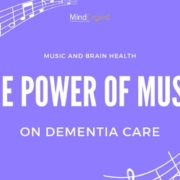How do Brain Cells Die in Alzheimer’s? What are Amyloids?
Discover what happens inside of the brain in Alzheimer’s disease. How do brain cells die? What are beta-amyloid plaques and tau tangles exactly?
Every day we are closer to understanding how brain cells die in Alzheimer’s disease. Beta-amyloids and tau proteins form part of a healthy brain. But in Alzheimer’s disease, a series of changes take place in the brain.
How do these changes manage to trigger brain cell death in Alzheimer’s?
Matt Huentelman, Ph.D., neuroscientist and a human genetics researcher, explains this process in very simple terms.
Do Brain Cells Die as we Age?
With normal aging, we don’t find that neurons die in massive numbers. While with Alzheimer’s disease, the neurons or brain cells die in large numbers in certain areas of the brain.
This is the end product of the process of Alzheimer’s disease. Alzheimer’s causes neuron death. And this neuron death manifests as memory, thinking, and behavior changes.

But your brain is so resilient that it is able to adapt for many decades to this cell death.
Neuroscientists believe that when the very first signs of memory, thinking or behavior changes appear in an Alzheimer’s patient, their neuron loss is approximately 70% in certain areas of the brain.
This 70% loss represents a massive number of dead neurons in brain regions that are earliest affected by Alzheimer’s disease.
It is a truly remarkable process. Your brain is fighting and largely maintaining cognitive skills until you reach some sort of critical point. It is at this juncture, where a very large percentage of neurons are missing from the brain regions critical for memory formation, that Alzheimer’s becomes evident.
It is one of the most impressive things, that our brain is able to fight this process, and do a pretty good job of fighting for so long.
What causes this cell death? Alzheimer’s affects two proteins, beta-amyloid and tau. It causes tangle and plaque formation, brain inflammation, lost connections, and neuronal death.
What are Amyloids and Beta-Amyloids?
Amyloids are self-assembled aggregates of protein. With Alzheimer’s disease we care most about beta-amyloids.
Beta-amyloids are microscopic protein fragments that are produced in our brains in a natural manner. In Alzheimer’s disease the balance of these amyloids shifts towards an amyloid type called beta 1-42.

That type of amyloid tends to be sticky and forms what we call amyloid plaques. Clumps of this amyloid sit outside of the brain cells. These amyloid deposits suffocate the neurons and make it harder for them to communicate.
We don’t know yet if the amyloid is the direct cause of the death of the cell or if something else a little bit further downstream is the culprit. That’s why we need to talk about tangles.
What are Tau Tangles?
Tau tangles or neurofibrillary tangles are clumps of a protein called tau and happen inside the neurons, inside brain nerve cells that are important for memory.
Tau protein is abundant in neurons and helps stabilize their axons. Thus, tau is important for normal neuron function.
During Alzheimer’s disease tau changes and clumps together, like the amyloid beta. But in this case the clumps happen inside the cells.
These clumps are called tangles because the tau protein looks like a helix – similar to DNA – but it’s a single helix. And these helices tangle up like a hairball.
How do Brain Cells Die in Alzheimer’s?
In Alzheimer’s disease both of these amyloid plaques and tau tangles happen. The amyloid plaques happen first and the tau tangles happen a little bit later. But eventually the neuron that has tau tangles inside dies.
When the tangle overpowers the brain cell, neural communication processes can slow down and be eventually blocked entirely.
Imagine you are trying to shove something through a small tube and there is a clog in the tube. Quite similar to getting a clog in your house pipes. Once the clog is there, it’s really hard for the water to go through. And that’s exactly what happens to the neurons.

Brain cells like to “talk” to each other and receive input from each other. Once neurons are unable to communicate, they begin to die.
There are diseases where you only observe amyloid plaques, and diseases where you see only tangles. But Alzheimer’s disease by definition has both. When you look at an Alzheimer’s disease patient’s brain at autopsy you can see both amyloid plaques and tau tangles.
What is Cognitive Reserve? Could It Help Reduce the Risk of Dementia?
To help define cognitive reserve we will draw an analogy between car tires. Cognitive reserve is like having more tread on the car tires. Cheap tires are thinner and wear out faster and expensive tires that have more tread, last longer.
Some studies suggest that lifetime exposures including educational and occupational attainment, and leisure activities in late life, can increase this reserve. So, cognitive reserve holds out the promise of interventions that could slow cognitive aging or reduce the risk of dementia.
Let’s look at it this way: if my brain has more cognitive reserve I may be able to compensate for the ravages of Alzheimer’s disease for a longer period of time.

We have intuition that cognitive reserve is important but to actually study it in a fair way across large groups of people is very difficult. We would need a way to measure or score cognitive reserve and there’s not a clear way to do that.
If the key to Alzheimer’s disease were how strong your legs are, we have a very easy way to measure how strong everybody’s legs are. But such an approach is lacking for cognitive reserve. This makes the understanding of the importance of cognitive reserve difficult to fully assess. This is one of the reasons why the brain is so hard to study.
Keeping your brain active is good and may delay or slow down the symptoms of dementia.
YOU CAN MAKE A DIFFERENCE.
MindCrowd is the first online research project of its kind to study millions of individuals to help bring us closer to a cure for Alzheimer’s.
Help us reach the 1 million people mark.
Stay Tuned for News about Brain Aging and How you Can Use them to Avoid Cognitive Decline.
Matt Huentelman is a neuroscientist and a human genetics researcher. His laboratory studies how the brain ages and explores various ways in which we can prevent brain aging and protect against diseases of the aging brain like Alzheimer’s disease. His lab is based at TGen in Phoenix, Arizona, and he is also the lead scientist for the MindCrowd project.
MindCrowd is an internet based study of the brain that anyone 18 years of age or older can join and it can be found at mindcrowd.org




 MindCrowd
MindCrowd



Leave a Reply
Want to join the discussion?Feel free to contribute!